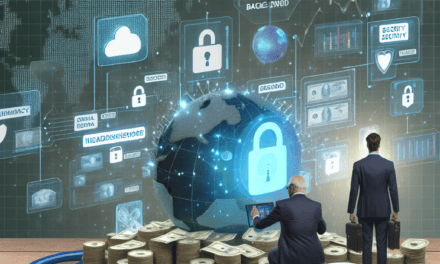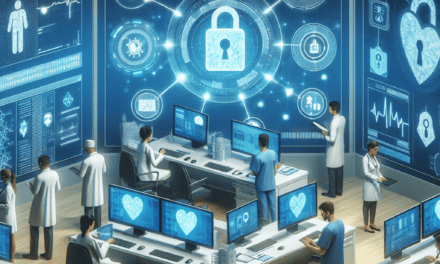Rising Cybersecurity Budgets Fail to Curb Attack Disruptions

In an era where digital transformation is at the forefront of business strategies, cybersecurity has become a critical concern for organizations worldwide. Despite the increasing allocation of resources towards cybersecurity, the frequency and impact of cyberattacks continue to rise. This article delves into the paradox of rising cybersecurity budgets failing to curb attack disruptions, exploring the reasons behind this trend and offering insights into potential solutions.
The Escalating Cybersecurity Budgets
Over the past decade, organizations have significantly increased their cybersecurity budgets in response to the growing threat landscape. According to a report by Gartner, global spending on cybersecurity is expected to reach $150 billion by 2023, reflecting a compound annual growth rate of 8.5% from previous years. This surge in spending is driven by several factors, including regulatory compliance, the increasing sophistication of cyber threats, and the need to protect sensitive data.
Despite these investments, many organizations find themselves struggling to keep pace with the evolving threat landscape. The complexity of modern IT environments, coupled with the rapid advancement of cybercriminal tactics, has made it challenging for businesses to effectively defend against attacks. This section explores the reasons behind the escalating cybersecurity budgets and the challenges organizations face in achieving their security objectives.
Factors Driving Increased Cybersecurity Spending
Several key factors contribute to the rising cybersecurity budgets:
- Regulatory Compliance: Governments and regulatory bodies worldwide have implemented stringent data protection laws, such as the General Data Protection Regulation (GDPR) in Europe and the California Consumer Privacy Act (CCPA) in the United States. Compliance with these regulations requires significant investment in cybersecurity measures.
- Advanced Threats: Cybercriminals are employing increasingly sophisticated techniques, such as ransomware, phishing, and zero-day exploits, necessitating advanced security solutions to detect and mitigate these threats.
- Digital Transformation: As organizations embrace digital transformation, they expand their attack surface, making them more vulnerable to cyberattacks. This necessitates increased investment in cybersecurity to protect digital assets.
- Cloud Adoption: The shift to cloud-based services introduces new security challenges, requiring organizations to invest in cloud security solutions to safeguard their data and applications.
- Remote Work: The COVID-19 pandemic accelerated the adoption of remote work, leading to increased cybersecurity risks as employees access corporate networks from various locations and devices.
Challenges in Achieving Effective Cybersecurity
Despite the increased spending, organizations face several challenges in achieving effective cybersecurity:
- Complex IT Environments: Modern IT environments are complex and dynamic, making it difficult to implement and manage comprehensive security measures.
- Skill Shortages: The cybersecurity industry faces a significant skills gap, with a shortage of qualified professionals to manage and respond to security incidents.
- Rapidly Evolving Threats: Cyber threats are constantly evolving, requiring organizations to continuously update their security strategies and technologies.
- Integration Challenges: Many organizations struggle to integrate disparate security solutions, leading to gaps in their security posture.
- Budget Allocation: While budgets are increasing, organizations often struggle to allocate resources effectively, leading to inefficiencies in their security programs.
The Persistent Threat of Cyberattacks
Despite increased spending on cybersecurity, the frequency and impact of cyberattacks continue to rise. According to a report by Cybersecurity Ventures, global cybercrime costs are expected to reach $10.5 trillion annually by 2025, up from $3 trillion in 2015. This alarming trend highlights the persistent threat of cyberattacks and the challenges organizations face in mitigating their impact.
Types of Cyberattacks
Cyberattacks come in various forms, each with its own set of challenges and implications:
- Ransomware: Ransomware attacks involve encrypting an organization’s data and demanding a ransom for its release. These attacks have become increasingly common and costly, with high-profile incidents affecting organizations across various industries.
- Phishing: Phishing attacks involve tricking individuals into revealing sensitive information, such as login credentials or financial details. These attacks are often the entry point for more sophisticated cyberattacks.
- Distributed Denial of Service (DDoS): DDoS attacks involve overwhelming a network or website with traffic, rendering it unavailable to users. These attacks can cause significant disruptions to business operations.
- Insider Threats: Insider threats involve employees or contractors misusing their access to an organization’s systems and data. These threats can be intentional or unintentional and are often difficult to detect.
- Advanced Persistent Threats (APTs): APTs are prolonged and targeted cyberattacks in which an intruder gains access to a network and remains undetected for an extended period. These attacks are often carried out by nation-state actors and can have severe consequences.
Case Studies of Notable Cyberattacks
Several high-profile cyberattacks have highlighted the persistent threat of cybercrime:
- Colonial Pipeline Ransomware Attack (2021): In May 2021, the Colonial Pipeline, a major fuel pipeline operator in the United States, fell victim to a ransomware attack that disrupted fuel supplies across the East Coast. The attack was attributed to the DarkSide ransomware group, and the company reportedly paid a $4.4 million ransom to regain access to its systems.
- SolarWinds Supply Chain Attack (2020): The SolarWinds attack involved the compromise of the company’s Orion software, which was used by numerous government agencies and private organizations. The attackers, believed to be a Russian state-sponsored group, gained access to sensitive data and systems, highlighting the risks associated with supply chain attacks.
- Equifax Data Breach (2017): The Equifax data breach exposed the personal information of approximately 147 million individuals, including Social Security numbers and credit card details. The breach was attributed to a failure to patch a known vulnerability, underscoring the importance of timely software updates.
The Disconnect Between Spending and Security Outcomes
The disconnect between rising cybersecurity budgets and the continued prevalence of cyberattacks raises questions about the effectiveness of current security strategies. Despite significant investments in cybersecurity technologies and services, many organizations struggle to achieve their desired security outcomes. This section explores the reasons behind this disconnect and offers insights into potential solutions.
Misalignment of Security Priorities
One of the primary reasons for the disconnect between spending and security outcomes is the misalignment of security priorities. Organizations often focus on investing in the latest security technologies without fully understanding their specific security needs and risks. This can lead to a fragmented security posture and gaps in protection.
To address this issue, organizations should conduct comprehensive risk assessments to identify their most critical assets and vulnerabilities. By aligning their security investments with their specific risk profile, organizations can ensure that their resources are allocated effectively and that their security measures are tailored to their unique needs.
Ineffective Security Strategies
Another factor contributing to the disconnect is the reliance on ineffective security strategies. Many organizations adopt a reactive approach to cybersecurity, focusing on responding to incidents rather than proactively preventing them. This approach can lead to a cycle of continuous firefighting, with organizations constantly playing catch-up with cybercriminals.
To break this cycle, organizations should adopt a proactive security strategy that emphasizes prevention, detection, and response. This includes implementing advanced threat detection and response solutions, conducting regular security assessments and penetration testing, and fostering a culture of security awareness among employees.
Overreliance on Technology
While technology plays a critical role in cybersecurity, an overreliance on technology can lead to a false sense of security. Many organizations invest heavily in security tools and solutions without adequately addressing the human and process aspects of cybersecurity.
To achieve effective security outcomes, organizations must adopt a holistic approach that integrates people, processes, and technology. This includes investing in employee training and awareness programs, establishing clear security policies and procedures, and fostering a culture of accountability and responsibility for security.
The Role of Cybersecurity Culture
While technology and processes are essential components of a robust cybersecurity strategy, the role of organizational culture cannot be overlooked. A strong cybersecurity culture can significantly enhance an organization’s ability to prevent, detect, and respond to cyber threats. This section explores the importance of cybersecurity culture and offers insights into how organizations can foster a culture of security awareness and accountability.
Building a Culture of Security Awareness
A culture of security awareness involves educating employees about the importance of cybersecurity and their role in protecting the organization’s assets. This includes providing regular training on topics such as phishing awareness, password management, and data protection.
Organizations can foster a culture of security awareness by:
- Conducting Regular Training: Providing employees with regular training on cybersecurity best practices and emerging threats can help them recognize and respond to potential security incidents.
- Encouraging Open Communication: Encouraging employees to report suspicious activities and potential security incidents without fear of reprisal can help organizations identify and address threats more quickly.
- Recognizing and Rewarding Good Security Practices: Recognizing and rewarding employees who demonstrate good security practices can reinforce positive behaviors and encourage others to follow suit.
Fostering Accountability and Responsibility
Accountability and responsibility are critical components of a strong cybersecurity culture. Employees at all levels of the organization should understand their role in protecting the organization’s assets and be held accountable for their actions.
Organizations can foster accountability and responsibility by:
- Establishing Clear Security Policies: Clearly defined security policies and procedures provide employees with guidance on how to protect sensitive data and respond to security incidents.
- Assigning Security Roles and Responsibilities: Assigning specific security roles and responsibilities to employees can help ensure that security tasks are carried out effectively and that accountability is maintained.
- Conducting Regular Security Audits: Regular security audits can help organizations identify gaps in their security posture and hold employees accountable for their actions.
Innovative Approaches to Cybersecurity
As cyber threats continue to evolve, organizations must adopt innovative approaches to cybersecurity to stay ahead of cybercriminals. This section explores some of the emerging trends and technologies that are shaping the future of cybersecurity and offers insights into how organizations can leverage these innovations to enhance their security posture.
Artificial Intelligence and Machine Learning
Artificial intelligence (AI) and machine learning (ML) are transforming the cybersecurity landscape by enabling organizations to detect and respond to threats more quickly and accurately. These technologies can analyze vast amounts of data in real-time, identifying patterns and anomalies that may indicate a security incident.
Organizations can leverage AI and ML to:
- Enhance Threat Detection: AI and ML can help organizations detect threats that may go unnoticed by traditional security tools, such as zero-day exploits and advanced persistent threats.
- Automate Incident Response: AI and ML can automate routine security tasks, such as threat analysis and incident response, freeing up security teams to focus on more complex issues.
- Improve Threat Intelligence: AI and ML can analyze threat intelligence data from multiple sources, providing organizations with a more comprehensive view of the threat landscape.
Zero Trust Architecture
The zero trust architecture is an emerging security model that assumes that threats can originate from both inside and outside the organization. This model requires organizations to verify the identity and trustworthiness of users and devices before granting access to resources.
Organizations can implement a zero trust architecture by:
- Implementing Strong Authentication: Requiring multi-factor authentication (MFA) for all users can help ensure that only authorized individuals have access to sensitive data and systems.
- Segmenting Networks: Segmenting networks into smaller, isolated segments can help prevent lateral movement by attackers and limit the impact of a security breach.
- Monitoring User Activity: Continuously monitoring user activity can help organizations detect suspicious behavior and respond to potential security incidents more quickly.
Threat Intelligence Sharing
Threat intelligence sharing involves the exchange of information about cyber threats between organizations, industry groups, and government agencies. By sharing threat intelligence, organizations can gain insights into emerging threats and vulnerabilities, enabling them to better protect their assets.
Organizations can participate in threat intelligence sharing by:
- Joining Industry Groups: Joining industry-specific groups and forums can provide organizations with access to valuable threat intelligence and best practices.
- Collaborating with Government Agencies: Collaborating with government agencies can help organizations stay informed about emerging threats and regulatory requirements.
- Leveraging Threat Intelligence Platforms: Utilizing threat intelligence platforms can help organizations collect, analyze, and share threat intelligence data more effectively.
Conclusion
The rising cybersecurity budgets and the persistent threat of cyberattacks present a complex challenge for organizations worldwide. Despite significant investments in cybersecurity, many organizations continue to struggle with achieving effective security outcomes. This article has explored the reasons behind this disconnect, including misalignment of security priorities, ineffective strategies, and overreliance on technology.
To address these challenges, organizations must adopt a holistic approach to cybersecurity that integrates people, processes, and technology. This includes fostering a strong cybersecurity culture, leveraging innovative technologies such as AI and machine learning, and adopting emerging security models like zero trust architecture. By aligning their security investments with their specific risk profile and fostering a culture of security awareness and accountability, organizations can enhance their ability to prevent, detect, and respond to cyber threats.
Ultimately, the key to curbing attack disruptions lies in the ability of organizations to adapt to the evolving threat landscape and continuously improve their security posture. By embracing a proactive and comprehensive approach to cybersecurity, organizations can better protect their assets and ensure the resilience of their operations in the face of ever-evolving cyber threats.




